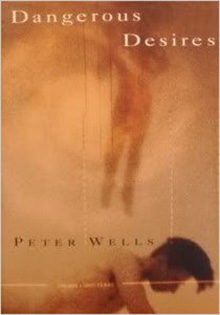 Dangerous Desires
Dangerous Desires
by Peter Wells
Published by Viking Adult
Published April 1, 1994 (Reissue)
Fiction (foreign)
224 pgs. • Find on Amazon.com
Reviewed by Stephen O. Murray
January 4, 2004
Originally published in New Zealand in 1991, winning multiple literary awards there, and published with substantial promotion in the US in 1994, Dangerous Desires, the collection of three long stories (novellas) and five short stories by film-maker Peter Wells (1950– ) is uneven, ranging from the banal and the familiar (three stories about the friend of man dying of AIDS) to original and unfamiliar, particularly in “Of Memory and Desire.”
As are all the other pieces, the major events in “Of Memory and Desire” take place in New Zealand, but the New Zealanders are minor players. The main characters are a short and plain Japanese woman, Sayo, who marries a tall and handsome Japanese man, Keiji. The couple marry in New Zealand and honeymoon amidst a Japanese group bus tour of New Zealand. The first half of “Of Memory and Desire” is more sexually graphic than any of the gay stories.
A cover blurb (from Los Angeles essayist/short story writer Bernard Cooper) invokes “the redemptive power of sex,” though I don’t see much redemption—and when it seems that it is going to come (particularly in the last story), it doesn’t. There is quite a lot of sex occurring in the eight stories, but when it is good, the relationships are brief, and sex is often shown as increasing loneliness rather than assuaging it. This is especially the case in “Encounter” which recalls a white boss’s young son molesting an adult Maori worker afraid to protest the unwanted advances (but finding ways to make the depredations unsatisfying for the boy).
There is some mutually satisfying gay sex in another of the long stories, “Bum to You, Chum,” although that story is primarily about finding out about a mother who the gay protagonist, Nick, knew as a fictive “aunt.” (That is, besides not knowing she was his mother, he did not even know “Aunty Tizz” was his grandmother’s daughter, which strains my credulity.) “Bum to You, Chum” has some surprises, which is more than I can say for the three Eric-Perrin stories. The other of the long stories, “One of them!” has a predictable end, though it has an interesting trajectory and provides a credibly poignant portrait of the friendship between two isolated adolescent males terrified of their dangerous desires (to borrow the book’s portentous, trite title).
The stories excel in showing the frustrations of gay men (and boys feeling homoerotic urges) in isolated, homophobic rural New Zealand (“Their relationship after this was whatever two men can achieve in a small town full of eyes, where a mutual dissatisfaction translates into a kind of rancor which forbids true happiness or ecstasy in others; in fact, sees it as a kind of reproach” 22). The shorter stories strike me as wispy; the longer ones are substantial in rich content, not just longer. I also think that Wells stints on catharsis, though there is a measure of it in the three longer stories (especially in “Of Memory and Desire”). Catharsis is particularly notably missing in “Dark and Light,” the short story placed last in the book and ending with yet another failure of connection. Even where there is some catharsis, the stories end in sadness about missed opportunities for emotionally satisfying relationships. Although spiced up with explicit sex and complicated relationships, the book ultimately seems to be serving up a steady diet of something like mutton, varied by small servings of lamb, but not varying very much in the thick sauce of sadness.
first published on AssociatedContent, 4 January 2004
©2004, 2017, Stephen O. Murray

